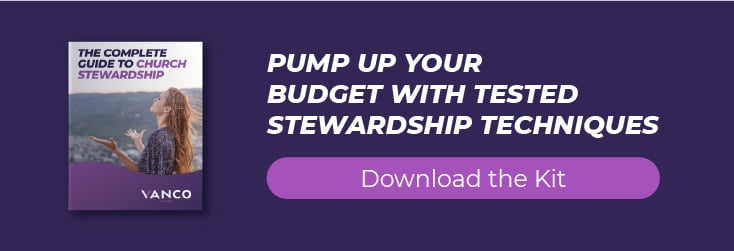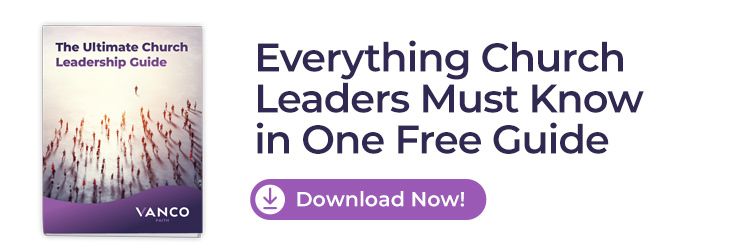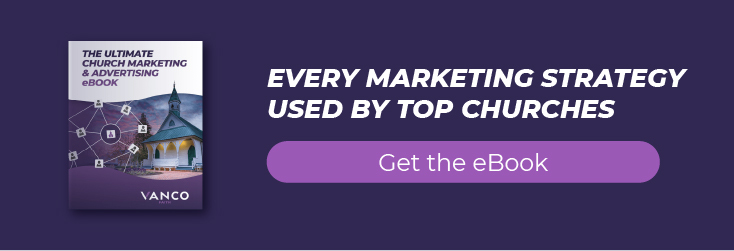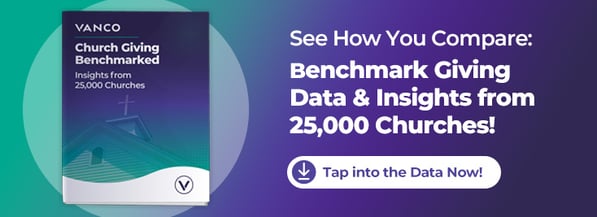
Is your church struggling to maintain a balance between good stewards and good tithers throughout the year? Do you find yourself going from quarter to quarter without a solid following? Don't feel bad. You're not alone.
Churches without a sound stewardship plan tend to have a transient population. Members that come and go leads to unstable financial support. To maintain balance, you'll need a solid plan.
Not sure how to create an annual church stewardship plan? Keep reading to learn how to develop a plan for your church, plus a few examples.
A Comprehensive Stewardship Plan Works for Any Size of Church
It doesn't matter if you have 50 members or 5,000 members. You can create a stewardship plan for your church. The plans are catered to your church's needs and ability to get buy-in from parishioners.
There are various components to a comprehensive giving strategy. You can implement all of them or just a few. The last thing you want to do is overwhelm your congregation by constantly asking for money.
Congregations want to see a manifestation of their giving. Follow through on promises. If a campaign is geared toward global missions, make sure it's used for its intended purpose.
Let's take a look at some components of a stewardship plan.
1. Annual Goal
The first step is to decide on an annual goal. Are you looking to boost annual tithes and offerings? Is there a specific reason why the church needs a new roof or wants to add to its transportation fleet?
Review the past five years of giving to see if your congregation can reach the goal in one act of giving. Perhaps your annual goal is to raise funds for multiple initiatives.
Clarity is important to keep you and your teams focused on the goal.
2. Capital Campaigns
Capital campaigns are common in churches that want to avoid taking out loans for large expenditures. Churches have similar struggles as small businesses when it comes to getting loan approvals. Part of the process is showing lenders there's an active membership roster that consistently gives.
The church's income is based on tithes and offerings, so finance records must support a steady level of giving. Because it's sometimes difficult to account for low months of giving, the most feasible option is capital campaigns.
Raising money for a major repair is easier than raising money for a new building. The latter may require a multi-year campaign.
3. Financial Responsibility
Financial responsibility is two-fold. The church must become responsible in its handling of tithes and offerings. The Bible instructs us on being a good steward.
To do so, the church must handle the money it takes in responsibly. Ensure the necessary expenses such as the mortgage and utilities are paid first. Don't hire staff for roles a volunteer can handle. Have transparency and show the congregation how the tithes are being spent.
In Malachi 3:10, the Bible commands that we bring the tithe into the storehouse for the congregation. In today's terms, the storehouse is the church. The pastor has an obligation to teach on tithing to ensure there is enough money to sustain the church.
4. Ministry Spotlights
Church stewardship is about the church as a whole and the smaller ministries responsible for fulfilling discipleship duties. It's valuable to the church to have strong, active and engaged ministries.
Ministries demonstrate the works of the church and are showing the need for strong stewardship. Not every member volunteers within the church, but they'll support good works.
Spotlight those works as part of your plan. Also, ministries should have their own stewardship goals to ensure their projects are fully funded.
5. Outreach Opportunities
Churches must plan for opportunities to go outside the church and into the surrounding communities. Outreach ministry is a way to demonstrate discipleship. There are numerous ways to achieve this goal.
Your outreach ministries can partner with other churches or organizations to achieve a common goal.
There are also mission trips that allow the ministry to travel beyond its borders both financially and physically.
Outreach is one component of church stewardship that congregants are eager to support.
6. Programs and Events
Funding programs and events is another way to build a strong stewardship plan. Although these activities require financial support, they often pay for themselves and bring in revenue.
Most events are centered around individual ministries and can draw different audiences from outside the church. Bringing in people from outside the church is a good thing. Because you do not depend on the congregation to support every effort, and you're creating a chance for discipleship.
Programs and events are a great way to minister, as well as grow your membership. Visitors come into the church for what you're offering, and you're given a new chance to disciple and convert visitors to members.
7. Targeted Sermons Topics
Targeted sermon topics fit perfectly into stewardship plans. These topics are presented as a theme. You can have one a month, every quarter or in conjunction with special dates throughout the year.
The purpose of targeted topics is to reinforce the necessity of commitment to the church as a whole. Topics include being an active participant, volunteerism and tithing. Include scriptures that support these topics.
The foundation of the sermons is a reminder to the congregation that discipleship is a lifelong commitment.
8. Testimonials
Testimonials are personal statements by individuals and groups that have benefited from their relationship with the church. The purpose is to show how their belief and commitment to doing God's work has allowed them to live a prosperous life.
Testimonials come in various ways. Some are planned, while others are spontaneous. When the congregation sees an example of someone who has benefited from their commitment to the church, they want to replicate it for themselves.
Some southern churches still host testimonial services. In these services, people have the opportunity to share how their lives have been blessed. They share their experiences and show how obedience worked in their favor.
Create a Realistic Annual Budget
As mentioned above, your church is a business, and as such, it should have a budget. Because the church is a unique business model, it must rely on different factors. Instead of customers and clients buying a product or service, the church relies on financial contributions.
If you're fortunate enough to have a social services branch, you can qualify for faith-based grants and additional funding. This money will help with your community outreach initiatives.
A church budget must include all operational costs, employee salaries, benefits, insurance, third-party costs, programs and events.
How Committed are Your Members
The delicate part of creating the budget comes with calculating anticipated revenue. How do you anticipate giving? How do you measure what 10 Percent looks like when you do not know the salary of members or their commitment to tithing each week?
These are questions your budget has to address. Some churches go so far as to request the annual income of their members. This is an approach that's often frowned upon.
A better approach is to use the past five years of giving and look for the following trends:
- Overall increases and decreases in giving.
- Fluctuations in giving within each year.
- Overall increases and decreases in attendance.
- Are there months where attendance and giving decrease or increase.
- What events or fundraisers brought in the most revenue.
Honesty in the budget process is a key component of a church stewardship plan.
Appoint a Team to Explore Stewardship Opportunities
The work of creating a church stewardship plan shouldn't get left to the pastor and administrative staff. Now is the time to bring in the business-minded leaders within your church and community.
Too often, religious organizations believe their finances and procedures are for church leadership eyes and ears only. The truth is, great minds are in the congregation, and their insights can help you grow your ministry.
Inviting business people into your planning discussion can bring about ideas and resources you never imagined. Building business partnerships has benefits that will help the church and the congregations.
The stewardship planning committee could act as a specialized board that's responsible for building community-based relationships. It's also responsible for reviewing and making recommendations for programs and events.
Bring in the Marketing and Media Ministry
Once your comprehensive stewardship plan comes together, it's time to bring in the marketing and media teams. These ministries are vital to effective messaging. They're responsible for relaying the plan and the intended outcome.
It doesn't matter the size of your church. It would help if you had someone or a group that can communicate crucial information. In the digital era, a media ministry makes it easier to assimilate effective messaging.
Get the right people on your team for the following tasks:
- Church announcements.
- Digital marketing.
- Quarterly and annual statement cover letters.
When it comes to church announcements, media ministries are creating innovative and engaging video productions. These require a good camera, low-cost editing apps, and imagination.
Use digital church marketing to promote upcoming sermon series, events and other church news. It's a great way to stay in touch with seasonal members, elderly members and those that attend via virtual services.
Every church should make available quarterly and annual statements to its members. They hold members accountable for their responsibilities to the church. If a member has pledged an amount to a financial campaign, the quarterly statement shows their progress.
The cover letter for statements has key points, including a message from the pastor thanking the member for their commitment.
Build or Upgrade Your Church Website
By now, every church should have a website. Like most businesses, having a digital platform expands your reach. A church website is not only an online business card, it's a central location for members to find information.
Your website is also used to promote ministries and provide contact information on joining those ministries.
Every church website needs an about page, a minister biography page, an online giving link and information about its history.
For ministries with a stewardship plan beyond the physical church, social media has become an intricate part of the ministry. Once frowned upon, the church is now reaping the benefits of building online and global audiences.
Connecting your church website and your social media channels is a way to utilize search engine optimization for greater exposure.
Incorporate Church Management Tools
Technology is our friend and has made life much easier in every aspect of life. There is no reason for ministries not to use it. Church management software is keeping ministries inline with other business models.
You're able to integrate the software with multiple programs to streamline processes. Integrations include software to make online giving the preferred method of financial transactions.
Event registration software and apps remove the administrative staff from the process. When members register online and pay applicable fees, you no longer have to track people down and account for funds.
Stewardship Ideas for Your Church
As you can see, there are many aspects to stewardship that go beyond giving money. A church stewardship plan encompasses growing a healthy church.
Here we'll explore some ideas to include in your long-term comprehensive stewardship plan.
Build Your Church Brand
Branding expands across industries. Today's church understands the need to create an identity that speaks to their core values and audience. Church branding is a part of your stewardship plan because it must gain acceptance within the congregation.
Once the brand is approved, it becomes a part of the church's overall vision and mission statement.
As with any business, your brand includes a logo, slogan or tagline and color scheme. The brand is incorporated into marketing and media strategies. If you're looking for a step-by-step process to enhance your brand, check out this short course we provided. It also has free tools you can use to streamline your work.
Live Streaming
Live streaming tools will expand your reach beyond the physical congregation. Streaming gives you the chance to build an online community that's just as vital to stewardship as members that attend in person.
Live broadcast tools included within apps allow your media ministry to:
- Broadcast simultaneously on multiple social platforms.
- Broadcast messages outside of regular church services.
- Provide individual ministries with added visibility.
- Broadcast on-screen messages.
- Promote upcoming events.
- Promote ways to give.
eGiving
As Live streaming becomes more prevalent in the church, you'll have a broader audience. eGiving allows the church to offer simple methods for accepting donations. Text giving, apps and other means of online giving makes it easier for global audiences to donate to your ministry.
Develop a Mission Statement
A stewardship plan is made stronger with a mission statement. Your mission statement is a short, memorable passage that members identify as the church's promise or goal.
The mission statement is posted during church announcements, on the website, on social media channels, church programs and other locations.
Some churches go as far as having members recite the mission statement as part of their weekly services.
Reexamine Your Ministries
Before creating a budget for your upcoming fiscal year, consider revisiting your church ministries. Ask the following questions:
- Is the ministry performing to your expectations?
- Are the ministry operations cost-effective?
- Can ministries with similar goals merge to reach a bigger audience?
- Are the current ministry leaders effective in creating and reaching goals?
- Should the current ministry budget get increased or decreased funding?
After reviewing the ministries, meet with their leaders to discuss your findings. Have the ministry leader submit a proposal for the new year. The proposal includes any events they're considering and ways to attract new ministry participants.
Use Church Offering Videos
When it comes to creating a successful annual stewardship campaign, one effective tactic is to use church offering videos. By designating a specific time during worship services to play a video with warm and inviting visuals and music, churches can make it easier to ask for donations and create a more comfortable atmosphere for their congregation.
Vanco offers a range of church offering videos, including one with and one without sound, that can be played on a projector to inspire giving and foster a sense of community.
And if you're looking for even more video resources, be sure to subscribe to our YouTube channel. We offer a variety of welcome, prayer, and countdown videos, as well as free instructional guides on church growth and stewardship. With Vanco's resources at your disposal, you'll be well-equipped to create a successful annual stewardship campaign that inspires giving and helps your church thrive.
Implement New Membership Training
If your church isn't doing it already, you need to implement a new membership training as part of your stewardship plan. Too often, people join a church without fully understanding what it means to become a member.
The level of membership training depends on how serious your church takes discipleship. Churches are charged with building character and commitment. To set a strong foundation and ensure membership doesn't become a revolving door, people need guidance.
Membership training often takes place over several weeks. With technology, you can offer a self-paced course online.
Use the training as a chance to learn what ministries' new members are interested in joining.
Do a Church Survey
There is sometimes a hesitancy in implementing a church survey. It's safe to say the truth hurts. At the same time, you can't plan for the church's future if you're operating under the wrong pretense.
A church survey provides vital information. There are outside sources you can employ to conduct the survey. Companies offering surveys also provide an extensive breakdown of what the results mean.
Or, you can use a free service like SurveyMonkey to create your surveys. if you're looking to create your own surveys, try this free guide, which has the resources you need to get started.
Invest in Community Partnerships
Community partnerships include relationships with organizations to provide much-needed services to those in need. During COVID19, churches partnered with grocers and food banks to feed families experiencing job losses. They also opened their doors to provide COVID testing sites.
Partnerships go into many industries and educate members on things like managing their health, finances and homeownership.
Hosting workshops with invited partners following church business meetings will get more members involved. A workshop can focus solely on creating an annual stewardship plan that includes investors, educators and healthcare professionals.
Utilize Sermon Series
Sermon series differ from targeted topics. A sermon series is a multi-part series that spans several weeks. The series is marketed to the church, includes banners, intro videos and handouts.
Using sermon series, the members become vested in the series, increasing attendance and online viewing. A series is a comprehensive approach to giving an in-depth look at scriptures.
Another way to use a sermon series is during pastor and church anniversaries. You can use a single scripture and have each guest speaker create a sermon on that scripture. Afterward, the series is packaged and made available for purchase.
Build an Online Directory
A church directory is as simple as an Excel spreadsheet or advanced as a social media model. Online directories are an extension of the church website. Once someone becomes a church member, they're granted access to create a listing in the directory.
The church has control over the information entered by setting parameters. You request basic data like name, address, phone and email. You can also allow members to upload photos.
Some directories have chat features and groups for ministries. Others are focused on building community and increasing engagement.
Move From Fundraisers to Financial Investments
For too long, churches have relied on fundraisers to make-up budget deficits. It's time to move away from practices that yield small returns. Churches around the globe understand the need for financial investments that will become a steady stream of revenue.
Financial investments are often non-profit business models such as preschools. Human service centers that qualify for faith-based grants are another popular option.
Also, churches operate book stores and even coffee shops on their campuses.
A model like this is beneficial to all parties and allows the church to invest in its members. These are all ways to grow revenue and create employment opportunities.
Get the Free eBook to Improve Church Stewardship
Keeping the lights on, the doors open and missions funded isn't what inspired most church leaders to pick their career, but it is key to the health of the church and the congregation. Discover how to become a master of church stewardship with our ultimate guide.





















